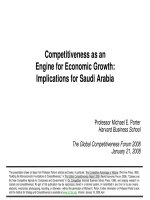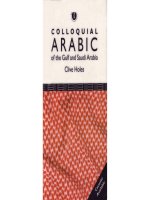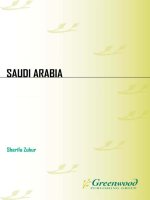culture shock! saudi arabia
Bạn đang xem bản rút gọn của tài liệu. Xem và tải ngay bản đầy đủ của tài liệu tại đây (4.58 MB, 297 trang )
Saudi Arabia
A Survival Guide to Customs and Etiquette
CultureShock!
Peter North
Harvey Tripp
cs! saudi arabia.indd 1 6/23/09 12:14:37 PM
A Survival Guide to Customs and Etiquette
CultureShock!
Saudi
Arabia
Peter North
Harvey Tripp
CS-00-Saudi Arabia.indd i 7/2/09 1:45:58 PM
This 3rd edition published in 2009 by:
Marshall Cavendish Corporation
99 White Plains Road
Tarrytown NY 10591-9001
www.marshallcavendish.us
First published in 2003 by Times Media Pte Ltd; 2nd edition published in 2006,
reprinted 2007.
© 2009 Marshall Cavendish International (Asia) Private Limited
All rights reserved
No part of this publication may be reproduced, stored in a retrieval system
or transmitted, in any form or by any means, electronic, mechanical,
photocopying, recording or otherwise, without the prior permission of
the copyright owner. Request for permission should be addressed to the
Publisher, Marshall Cavendish International (Asia) Private Limited, 1 New
Industrial Road, Singapore 536196. Tel: (65) 6213 9300, fax: (65) 6285 4871.
E-mail:
The publisher makes no representation or warranties with respect to the
contents of this book, and specifi cally disclaims any implied warranties or
merchantability or fi tness for any particular purpose, and shall in no events
be liable for any loss of profi t or any other commercial damage, including but
not limited to special, incidental, consequential, or other damages.
Other Marshall Cavendish Offi ces:
Marshall Cavendish International (Asia) Pte Ltd. 1 New Industrial Road,
Singapore 536196
Q
Marshall Cavendish Ltd. 5th Floor, 32-38 Saffron Hill,
London EC1N 8FH, UK
Q
Marshall Cavendish International (Thailand) Co Ltd.
253 Asoke, 12th Flr, Sukhumvit 21 Road, Klongtoey Nua, Wattana, Bangkok
10110, Thailand
Q
Marshall Cavendish (Malaysia) Sdn Bhd, Times Subang,
Lot 46, Subang Hi-Tech Industrial Park, Batu Tiga, 40000 Shah Alam, Selangor
Darul Ehsan, Malaysia
Marshall Cavendish is a trademark of Times Publishing Limited
ISBN: 978-07614-5674-2
Please contact the publisher for the Library of Congress catalogue number
Printed in Singapore by Times Printers Pte Ltd
Photo Credits:
All black and white photos from altTYPE/Reuters except pages 59, 117 (Ian
Blain); page 7 (Focus Team, Italy); page 181 (Angela Jackson); pages 13, 152
(Photolibrary). Colour photos from Corbis pages a, b–c, f–g, i, j–k; altTYPE/
Reuters d–e, p; Photolibrary pages h, l–m, n–o
Q
Cover photo: Corbis
All illustrations by TRIGG
CS-00-Saudi Arabia.indd ii 7/2/09 1:45:59 PM
ABOUT THE SERIES
Culture shock is a state of disorientation that can come over
anyone who has been thrust into unknown surroundings, away
from one’s comfort zone. CultureShock! is a series of trusted
and reputed guides which has, for decades, been helping
expatriates and long-term visitors to cushion the impact of
culture shock whenever they move to a new country.
Written by people who have lived in the country and
experienced culture shock themselves, the authors share all the
information necessary for anyone to cope with these feelings
of disorientation more effectively. The guides are written in a
style that is easy to read and covers a range of topics that will
arm readers with enough advice, hints and tips to make their
lives as normal as possible again.
Each book is structured in the same manner. It begins
with the fi rst impressions that visitors will have of that city or
country. To understand a culture, one must fi rst understand the
people—where they came from, who they are, the values and
traditions they live by, as well as their customs and etiquette.
This is covered in the fi rst half of the book.
Then on with the practical aspects—how to settle in with
the greatest of ease. Authors walk readers through topics
such as how to fi nd accommodation, get the utilities and
telecommunications up and running, enrol the children in
school and keep in the best of health. But that’s not all. Once
the essentials are out of the way, venture out and try the food,
enjoy more of the culture and travel to other areas. Then be
immersed in the language of the country before discovering
more about the business side of things.
To round off, snippets of basic information are offered
before readers are ‘tested’ on customs and etiquette of the
country. Useful words and phrases, a comprehensive resource
guide and list of books for further research are also included
for easy reference.
CS-00-Saudi Arabia.indd iii 7/2/09 1:45:59 PM
CONTENTS
Foreword vi
Acknowledgements viii
Map of Saudi Arabia x
Chapter 1
First Impressions 1
Getting There 3
Chapter 2
Land and History
of Saudi Arabia 10
The Beginnings 11
The Lie of the Land 12
Trading with the World 14
The Al Sauds 16
Saudi Arabia: the Early Days 18
The Origin of Islam 22
The Spread of Islam 28
Today’s Islam 30
Pan-Arab Brotherhood:
In Formation or Disarray?
35
Sunnis and Shi’ites 38
Saudi Arabia and Israel 39
Oil and the Economy 41
The Government
of the Present Day
45
Chapter 3
Who are
the Saudis? 49
From Bedouinism to Opulence 50
The Population Explosion 50
Family Values 52
Names and Labels 54
Interaction Between
the Sexes
55
Saudi Women 59
Women and Religion 62
Acquiring an Identity 62
Women in the Workforce 65
Qur’an and the Law 67
Swapping Cultures 70
Saudi Arabia’s Bedouins 71
Education 73
Chapter 4
Getting to
Know the Saudis 77
The Cultural Divide 78
The Worker Bees 79
The Pecking Order 82
Long Term Immigrants 83
Separate Societies 84
Expatriate Women 86
Male Bonding 89
Dress Code for
Saudi Men
90
Dress Code for
Saudi Women
92
Dress Code for
Aliens: Men
94
Dress Code for
Aliens: Women
96
Religious Freedoms 98
Weddings and Funerals 100
Falling Foul of the Law 101
Security and Safety 102
The Ultimate Penalty 104
Paying Blood Money 106
Security of Saudi Arabia:
the Country
106
Chapter 5
Settling In 111
Expectations 112
Visas and Documentation 113
Pre-Arrival Checks 115
Accommodation 116
Facilities for
the Handicapped
119
Money and Banking 120
Appliances 122
Help Around
the Home
123
Travel by Car 123
Taxis 128
Postal 129
Television 130
Shopping 132
CS-00-Saudi Arabia.indd iv 7/2/09 1:45:59 PM
Chapter 6
Food and
Entertaining 136
Traditional Fare 137
Restaurants 139
Domestic Hospitality 140
Entertaining,
Bedouin Style
142
Coffee Shops 144
Alcohol 146
Chapter 7
Sights and Sounds
of Saudi Arabia 149
Survivng the Climate 150
What Day Is It? 153
Public Holidays 156
Architecture 157
Museums 158
Literary and Visual Arts 159
Finding Your Way Around 161
The Saudi Arabian
Countryside
162
Hotels 167
Travel by Train 168
Travel by Air 168
The Number
One Attraction
169
Touring Outside
the Kingdom
176
Taking Pictures 178
Entertainment and Leisure 179
Saudis and Sport 180
Guest Workers and Sports 188
Chapter 8
Learning Arabic 191
Speaking Arabic 192
Reading Arabic 195
Writing Arabic 195
Arabic as Spoken
by Arabs
196
Learning Arabic 197
Common Arabic expressions 198
Saudi’s Second Language 199
Body Language 199
Chapter 9
Working and
Doing Business
in Saudi Arabia 201
Economic Development
and the Labour Force
202
Why Can’t the Saudis
Run Their Own Country?
203
Will You Be Replaced
By a Saudi?
207
Perpetual Trainees 211
Inshallah: Philosophy
or Crutch?
213
Religion in the Workplace 213
Employment Contracts 216
Commercial Law 220
Income Tax 221
Negative Comment 222
Getting On With the Boss 222
Who’s In Business 224
Corruption 226
Further Information
on Business Contacts
227
The Bureaucracy 229
Chapter 10
Saudi Arabia
at a Glance 232
Famous People
of Saudi Arabia
237
Culture Quiz 242
Do’s and Don’ts 248
Glossary 250
Resource Guide 253
Further Reading 260
About the Authors 266
Index 268
CS-00-Saudi Arabia.indd v 7/2/09 1:45:59 PM
vi
FOREWORD
In his book The 100: A Ranking of the Most Infl uential Persons
in History, author Michael H Hart judged that the world’s most
infl uential person of all time was an Arab trader who lived at
the turn of the 6th and 7th centuries in Mecca in present day
Saudi Arabia. The name of this individual was Muhammad, the
founder of the Muslim religion. To Muslims, presently 20 per
cent of the global population, Muhammad was the Prophet who
delivered God’s word to the world. To non-Muslims, Muhammad
was the man who delivered the Muslim religion to the world.
Either way, Muhammad’s effect on global human affairs since
his own time has been profound.
The other major infl uence, in terms of recent global interest
in Saudi Arabia, was the discovery on the Arabian Peninsula
of the world’s biggest oil deposits. The development of the
Saudi oil fi elds after the 1940s cast Saudi Arabia as the swing
supplier of the world’s energy and the most infl uential member
of OPEC (Organisation of Petroleum Exporting Countries).
The interaction of these two factors, Islam and oil, have made
Saudi Arabia one of the most pivotal countries on the planet.
Oil and the income it has generated has had a profound
effect on the Saudi culture in this once dirt-poor country of
limited interest to the rest of the world. In the modern era,
Saudi Arabia’s economic prospects have varied with the oil
price. In 1940s and 1950s, as the the fi rst oil revenue fl owed
into the country, the Saudi Royal family fi rst experimented with
conspicuous consumption in its most extreme form—nearly
driving the country bankrupt in the process. After the fi rst
big oil price increase in 1973, Saudi Arabia spent some of
its petrodollars on national development and invested some
in Western banks. The Western banks in turn invested in
Latin American countries, which subsequently announced
an inability to repay their debts. Laundered through various
countries, these petrodollars found themselves in the accounts
of Swiss banks in the name of various unsavoury Third
World dictators—well beyond the reach of the Treasury of
Saudi Arabia, the ostensible owner of the money. The price
of oil peaked again in 1979 during the Iranian Revolution,
but then slumped over the 1980s and 1990s when Saudi
Arabia survived by defi cit fi nancing, building up a massive
CS-00-Saudi Arabia.indd vi 7/2/09 1:45:59 PM
vii
overseas debt. Since the oil price spike that started in around
2002, Saudi Arabia has applied the bulk of its funds from
the booming oil price into paying off its accumulated debt
and increasing its rate of development. As is common
knowledge, the oil price peaked at US$ 147 in mid 2008,
then quickly slumped as the great global economic
meltdown of 2008/2009 gathered pace. At time of writing
the oil price is around US$ 50. Where it will go from there
is anyone’s guess.
To implement its social and physical development
programme, Saudi Arabia has, for many years, imported from
other countries a guest workforce of skilled and unskilled
labour. Saudi Arabia has a guest labour force fi ve to six million
strong in a total population of 28 million. Opportunities are
many for guest workers inside Saudi Arabia to undertake
an enormous variety of labour contracts, occupations
and industries.
This book is principally written as an information guide
to Saudi’s army of guest workers. It also offers advice and
information for those visiting the kingdom to do business, visit
family members of guest workers and many other reasons.
While the major viewpoint taken is that of the Western
visitor who has accepted employment in Saudi Arabia, or is
considering doing so, the book also contains helpful hints for
guest workers from other countries. It offers thumbnail sketches
of important historical accounts that have created present-
day cultural attitudes, and includes information of day-to-day
events within Saudi Arabia.
As the title of the book suggests, an assignment in Saudi Arabia
is an experience in the clash of cultures. Saudi Arabia is located
in a part of the world where the cultural mix is pronounced.
Three of the world’s dominant religions—Islam, Christianity
and Judaism—originated in these ancient lands. In this region,
Islam, Christianity, Judaism, Buddhism, Taoism and various other
‘isms’ uneasily rub shoulders against each other on a daily basis.
Culture shock is a part of life in Saudi Arabia, both for the guest
workers and the indigenous population. Avoiding the pitfalls
of culture shock and getting the best out of your time in Saudi
Arabia are two of the main themes of this book.
CS-00-Saudi Arabia.indd vii 7/2/09 1:45:59 PM
viii
With thanks for contributions, advice and proof-reading
from Margaret Tripp, Charles Jamieson, Anton Mayer, Joseph
Elkhorne, Ian Blain, Angela Jackson and Len Tripp.
ACKNOWLEDGEMENTS
CS-00-Saudi Arabia.indd viii 7/2/09 1:45:59 PM
ix
Central Riyadh, Saudi Arabia, seen through mirrors from Faisaliah Towers.
CS-00-Saudi Arabia.indd ix 7/2/09 1:46:00 PM
x
MAP OF SAUDI ARABIA
IRAN
SAUDI
ARABIA
RIYADH
IRAQ
OMAN
YEMEN
EGYPT
SUDAN
ERITREA
ETHIOPIA
DJIBOUTI
SOMALIA
SYRIA
KUWAIT
PERSIAN
JORDAN
ISRAEL
R E D S E A
UAE
GULF OF ADEN
BAHRAIN
QATAR
ARABIAN
SEA
GULF
CS-00-Saudi Arabia.indd x 7/2/09 1:46:00 PM
‘The real meaning of travel, like that of
a conversation by the fi reside, is the discovery of
oneself through contact with other people ’
—Paul Tournier,
The Meaning of Persons
FIRST IMPRESSIONS
CHAPTER 1
CS-01-Saudi Arabia.indd 1 7/2/09 1:47:10 PM
CultureShock! Saudi Arabia
2
AS ONE OF THE AUTHORS OF THIS BOOK, when fi rst assigned to a
project in Saudi Arabia, the personnel agent dealing with the
paperwork jokingly referred to Saudi Arabia as a ‘sandpit’.
The remark conveys the mental impression of Saudi Arabia
as an austere barren strip of land peopled by men in fl owing
robes and women in black abayas, with vast expanses of
sand, oil wells, oil pipelines, big landscapes, big skies, stifl ing
heat and occasional camels strolling by.
On arrival, that may be pretty much the way you fi nd
it—at least so far as the countryside was concerned. But
Riyadh—modern skyline to an ancient town.
CS-01-Saudi Arabia.indd 2 7/2/09 1:47:10 PM
First Impressions
3
missing from this mental picture is the ubiquitous features
of the modern world, the cosmopolitan cities of high rise
buildings, the extraordinary airports, the spectacular eastern
architectural features in mosques and public buildings, the
freeways, the traffi c snarls and the shopping centres.
Most of the physical infrastructure you will see in Saudi
Arabia is modern for no better reason than almost all the
country’s infrastructure has been built in the last 50 years.
This appearance contrasts starkly with attitudes, some of
which haven’t changed greatly since the 7th century
AD.
Saudi Arabia is a modern country with some very ancient
ways. Therein lies Saudi Arabia’s culture shock.
GETTING THERE
It is just possible to enter Saudi Arabia by surface transport.
The border with Iraq is closed until the political climate
improves, but most of the other land borders are open.
Access is possible, with various degrees of diffi culty, through
most of the countries with which Saudi Arabia shares land
borders, Kuwait, Jordan, Yemen, Oman, the United Arab
Emirates (UAE) and the island kingdom of Bahrain which is
now connected to Saudi Arabia by causeway. People have
even been known to make landfall on Saudi Arabia by dhow,
one of the preferred methods of travel of previous eras and
still operating today. But overland and seaborne entry to
and from the country is unusual,
attempted only by the more
intrepid explorers. Most people
arrive and leave by air.
Almost all visitors to Saudi
Arabia enter through one of
three airports: one on the Red
Sea coast, one in the centre
of the country and one on the
Persian Gulf coast.
For those entering the
kingdom at night through the
Eastern Province’s Damman Airport, the oil bearing parts
The ‘Persian Gulf’ as it is denoted
on most maps of the Middle East
is more widely known in Saudi
Arabia as the ‘Arabian Gulf’.
Alternatively it is often referred
to merely as ‘The Gulf’. All three
terms describe the same body of
sea water between the Arabian
Peninsula on its western coast
and Iran on its eastern coast. In
this book, we are using the term
‘Persian Gulf’ throughout.
CS-01-Saudi Arabia.indd 3 7/2/09 1:47:11 PM
CultureShock! Saudi Arabia
4
of Saudi Arabia passing beneath the wings may seem like a
scene from Dante’s Inferno. Down below fl ickering orange
fl ares from a thousand oil wells stretch from one horizon to
the other, and out into the Persian Gulf. Even in these times
of increasing energy consciousness and concerns for global
warming, much of the waste gas associated with oil is simply
fl ared at the wellhead.
On fl ights by day, added to the same scene is the acrid
black smoke from burning this dirty gas. Usually, a robust
north-west wind carries these fumes away, spreading
them across the northern waters of the Indian Ocean.
But in still weather, the gulf coast may be wreathed in
a grey canopy of sulphurous fumes.
Further west, over the land of the interior and away
from the oil fi elds on the east coast, the orange desert
vista stretches mostly uninterrupted from one horizon to
another. Occasionally, dusty towns and a few large cities
pass under wings. From the air, most of Saudi Arabia
appears hot, hostile and featureless desert terrain as it
truly is at ground level.
Along the western edge of the
Arabian Peninsula is a mountain
range running parallell to the
Red Sea coast. The highest part
of this range, in the south-west
corner of the peninsula near
Saudi’s border with Yemen, is
the Asir region—the wettest part
of the country. Sufficient rain
falls here to plant and harvest
vegetables. From the air, by Saudi
standards, the Asir countryside
looks uncharacteristically green.
The Immigration Card
Like most places, entry to Saudi Arabia starts with fl ight
attendants distributing immigration cards shortly before
arrival. By the standards of immigration cards worldwide,
Saudi Arabia’s are remarkably user-unfriendly. An idea
Flying In
Saudi Arabian Airlines, also
known as Saudia, is the
Kingdom’s domestic and
international carrier. A number
of Asian, European and US
airlines service the three
major Saudi Airports to the
two coastlines and the central
region. Saudi Arabia can also
be reached via hub airlines
from the smaller Gulf states
like Bahrain, Dubai and other
UAE airports.
CS-01-Saudi Arabia.indd 4 7/2/09 1:47:11 PM
First Impressions
5
of how Saudis think can be gleaned from the fact that
the smallest fi eld width on the form is the one requiring the
most letters—your address in Saudi Arabia. If you are staying
somewhere like the Hilton, the form will allow just enough
room to provide a brief address; otherwise you will have to
abbreviate or attach a microchip.
The other fi eld of major interest on the card is that
asking you to state your religion. While back home one’s
religion may be a secret about which others are not legally
entitled to ask, Saudi Arabia is one of the few countries
in the world which asks you to declare your religious
allegiances on arrival. This might immediately suggest to
you, should you have been unaware of it, that in this place,
religion matters.
Saudis, like most religious people, consider their own
religion the one true faith. Though Saudi Muslim clergy may
come down hard on alternative religions, Islam does afford
some respect for the older religions, such as Christianity to
which it is related. Saudis tend to believe that everyone has
a religion of some sort. Since they pray at least fi ve times a
day, most Saudis don’t contemplate belief systems based on
the absence of any god at all.
Presented with the choice on the immigration card, that
asks you to summarise the state of your religious beliefs in a
space with room for about ten letters, you might be unwise
to write ‘atheist’ in this fi eld. It is better to declare one’s faith
in a false prophet than in no prophet at all. On the other
hand, Saudis are unlikely to be interested in the fi ne print
of your religious beliefs. Saudi Arabia doesn’t really need to
know, for example, whether you are a Seventh Day Adventist
or a Member of the Church of the New Order. The best
response, unless you happen to be a Muslim, is something
brief like ‘Christian’, ‘Hindu’ or ‘Taoist’. It almost goes without
saying that ‘Judaism’ is not the appropriate word to enter in
this fi eld.
On the Ground
Disembarking from the plane, your fi rst taste of the exotic
delights of the Middle East will be the airport itself. Sheiks,
CS-01-Saudi Arabia.indd 5 7/2/09 1:47:11 PM
CultureShock! Saudi Arabia
6
kings, emirs, sultans and presidents of the Middle East tend
to rival each other in expending public money (which, under
their system of government, is effectively their own money)
on extravagant public buildings. Modern-day Middle East
potentates attempt to outdo each other in the grandeur
of their airports, seemingly driven by the need to keep up
with the Joneses, or in the case of the movers and sheiks
of the Middle East, the Al Sauds. The lavish airports of the
Middle East have enabled architects of renown to design
and construct some of the modern world’s most impressive
major public buildings.
The three major airports in
Saudi Arabia are King Abdulaziz
International Airport in Jeddah,
King Khaled International
Airport in Riyadh and King
Fahd International Airport
in Dammam. Two of these
airports have at least one feature
that ranks as the biggest in
the world.
King Abdulaziz International
Airport services the western
side of the country, including
Mecca, and is ranked by at least
one authority as the world’s
most beautiful airport. It includes a special terminal, the
Hajj Terminal, used for handling Mecca’s annual infl ux of
pilgrims. The Hajj Terminal, open only for one month of the
year during the pilgrim season, is the world’s biggest single
terminal by area, capable of handling 80,000 travellers
per day.
King Khaled Airport in Riyadh serves travellers to the
centre of the country. King Khaled is the world’s biggest
airport by area—a total of 81 square miles—the size
of a large town. It also has the world’s biggest airport
mosque—a building capable of holding 5,000 worshippers,
with room for another 5,000 in balconies adjacent to the
building. The airport was built bigger than it needed to
The Middle Eastern countries
of the Arabian Peninsula are
extraordinarily over-serviced by
airports. For example, fi ve of the
seven emirates of the United Arab
Emirates (UAE)—Abu Dhabi,
Dubai, Fujairah, Sharjah and Ras
al Khaimah—have international
airports; Abu Dhabi now having
two with its second airport at
Al Ain. The maximum distance
between any two airports of the
single nation of the UAE is 180
km, with the airports at Dubai
and Sharjah within 20 km of
each other.
CS-01-Saudi Arabia.indd 6 7/2/09 1:47:11 PM
First Impressions
7
be. One third of King Khaled Airport has not been used
since it was fi rst opened.
King Fahd Airport at Damman, opened in 1999 to replace
the run-down Dhahran International Airport, serves the
eastern seaboard of Saudi Arabia, including the main oil
producing areas and Aramco, Saudi Arabia’s state-owned
oil company.
At the Immigration Desk
Entering Saudi Arabia is likely to be more arduous than
in most places. Of course experiences vary from visit to
visit and from one immigration offi cial to the next. But by
and large, Saudi Arabia would have to be one of the more
nerve-wracking countries in which to clear immigration
and customs.
Any number of stories can be told regarded the demeanour
of Saudi immigration officials who might seem, to the
traveller, to have been hand-picked for their brusqueness
and lack of humour. Entering the country, you may queue
up for an hour to clear immigration, and take another hour
to depart the airport. You will be told to form orderly lines
(something that Saudis themselves are not very good at) then
continually be shifted to different lines. When you reach the
head of the line, having perhaps been moved from one line
The cavernous duty-free shopping area of the King Khaled Airport in Riyadh.
CS-01-Saudi Arabia.indd 7 7/2/09 1:47:11 PM
CultureShock! Saudi Arabia
8
or another, you may be told you are in the wrong line, and
told to head back to the top of a different line. Needless to
say, the correct procedure is not to remonstrate. You’ll clear
immigration eventually.
Having received a passport stamp, the next step in the
entry procedure is to pass through customs. This, once again,
is more testing in Saudi Arabia than in most places. Not
only does Saudi Arabia have an extensive list of prohibited
imports, its customs officials are proportionately more
diligent at fi nding them. Customs offi cials in Saudi Arabia
are more to likely to ask you to open your bags than most
places. Alcohol, as it is well known, cannot legally be brought
into Saudi Arabia. Less well known prohibited imports are
a long list of seemingly innocuous products such as games
of chance like dice and backgammon, statutes or carvings
of objects in human and animal form, as well as chess sets,
radio transmitters and military equipment—not merely
ordinance, but uniforms too.
Do The Crime, Do The Time
Alcohol-related products, including wine making kits, books about
wine making or food items such as vanilla extract are prohibited
items. A friend of one of the authors lost a debate with a customs
offi cial that a packet of champagne yeast in his bag (perhaps packed
by someone else without his knowledge or permission) was really
for making bread. A couple of nights in the slammer was the penalty
for this offence.
Plus loss of yeast.
Porno photos, defi ned as naked fl esh anywhere between
neck and knees, are also not advisable imports. (If you really
need alcohol, porno pictures and champagne yeast, obtaining
them inside Saudi Arabia on the black market is a less risky
method of procurement).
Magazines with dubious political content are also looked
at with disfavour, in particular those containing articles that
could possibly be interpreted as critical of the host country.
Video tapes and DVD’s are likely to be taken away for on-
the-spot inspection. The contents of laptop computers may
CS-01-Saudi Arabia.indd 8 7/2/09 1:47:11 PM
First Impressions
9
also be subject to scrutiny. Importing contraceptives is
also banned, though they are obtainable over the counter
in the kingdom. For a while after they were introduced,
cell phones with cameras were also illegal. At time of
writing, we believe this rule has now been relaxed. But
it will pay to check in advance with your travel agent, or
Saudi employer.
Knowing all this (because you bought this book), you will
not be carrying any of these items. When challenged, you will
able to tell the customs offi cial you have nothing to declare. In
theory you should then pass through customs, possibly after
a bag inspection, and escape into the countryside, thinking
to yourself, “From here, things can only get better.”
The chances are, they will!
CS-01-Saudi Arabia.indd 9 7/2/09 1:47:11 PM
‘Come O men of Riyadh, Here I am,
Abdulazziz ibn Abdulrahman of
the House of Saud, Your rightful ruler.’
—Battle cry of Ibn Saud, Saudi Arabia’s fi rst king, on
defeating his rivals, the Al Rashid tribe at Riyadh in 1901
LAND AND HISTORY
OF SAUDI ARABIA
CHAPTER 2
CS-02-Saudi Arabia.indd 10 7/2/09 1:51:04 PM
Land and History of Saudi Arabia
11
THE BEGINNINGS
According to most historians, human civilisation fi rst started
when settlements based on permanent agriculture replaced
preceding hunter gatherer societies. Sometime around 3000–
4000
BC, in an area around present-day Kuwait and northern
Saudi Arabia, a tribe of people known as the Sumerians arose,
moved north and settled in a then-fertile region between the
Tigris and Euphrates rivers in present-day Iraq.
Sumeria was probably the fi rst place in which people in
the world formed a self suffi cient city state. Over a period of
about one thousand years, the Sumerians invented advances
such as writing, the wheel, the calendar, the seven day week,
the 24-hour day and the 360-degree circle. The Sumerian
tongue—unrelated to any language of the modern world—
was probably the world’s fi rst written language.
That civilisations rise and fall has been the mark of
history. Sumerian society stayed more or less intact for a
long time, but eventually succumbed to an invading race:
the Akkadians based in Akkad, the city that later became
Babylon. Culturally and administratively, the Sumerians were
far more advanced than their conquerors. As the two societies
merged, the Akkadians adopted most of the Sumerian
customs, culture and knowledge with the exception of the
Sumerian language.
For a while, the Akkadians and Sumerians maintained a
fractious relationship within their mixed society, reminiscent
CS-02-Saudi Arabia.indd 11 7/2/09 1:51:05 PM
CultureShock! Saudi Arabia
12
of the disharmonies between Arabs and Jews in the present
day. The Akkadians spoke a Semitic tongue that is probably
the genesis of the present-day languages of Hebrew and
Arabic. As an identifi able race, the Sumerians, along with
their language, were absorbed into Akkadian culture and
disappeared from the pages of history. But their great
civilising advances in administration, law, written language,
agriculture and science survived them.
Forces of nature rather than forces of man eventually
put paid to early settlements in Mesopotamia. The history
of many semi-arid regions has proved that one effect
of long periods of irrigated agriculture is environmental
degradation. Contaminated by salt, the Sumerian fi elds
became increasingly unfertile. Forests disappeared, and along
with them, the wildlife that Sumerians used to supplement
their diet. Rainfall declined and Mesopotamia depopulated.
Today’s salt marshes of Iraq serve as a reminder of the long-
term consequences of the process.
While the area north of the Arabian Peninsula, and the
peninsula itself, fell into decline, similar agriculture-based
societies advanced in places like Egypt, the Indus valley,
China and even the Andes. With the decline of Sumeria,
the Arabian Peninsula, being as desolate then as it is now,
is thought to have been almost uninhabited over thousands
of years. After their pivotal role in the foundation of human
history, the lightly inhabited lands of the Arabian Peninsula
became best known as trading routes from the Indies, the
countries of the horn of Africa and the Gulf states, to Asia
Minor and Europe.
THE LIE OF THE LAND
Saudi Arabia is the biggest country in the Middle East and
the 13th biggest country in the world. About the size of
Western Europe and one quarter the area of the USA, Saudi
Arabia occupies approximately 80 per cent of the Arabian
Peninsula—a large slab of land, roughly rectangular in
shape that juts into the northern seas of the Indian Ocean.
Saudi Arabia is hot and dry, and water is scarce. Annual
rainfall is low almost everywhere. The country has no
CS-02-Saudi Arabia.indd 12 7/2/09 1:51:05 PM
Land and History of Saudi Arabia
13
permanent rivers or lakes. The desert to the north, the Nafud,
extends as far as Syria and into Iraq. In the south-east, the
Rub al’Khali—the ‘Empty Quarter’—is one of the most arid
regions on Earth. In Saudi parlance, the Empty Quarter is
simply known as ‘The Sands’. Between the deserts of the
north and south, arid plains of gravelly sand stretch across
the centre of the country. The eastern seaboard along the
Persian Gulf is mainly fl at with rolling dunes. To the west,
a range of low mountains parallels the Red Sea coast, from
Jordan in the north to the hill country of the Asir region in the
far south-west. Only here, near the Yemen border, is there
signifi cant rainfall.
The total length of Saudi Arabia’s land borders are
4,400 km (2,700 miles). Bordering countries are Jordan, Iraq,
and Kuwait to the north, Qatar, the United Arab Emirates
(UAE) and Oman to the south-east, and the Republic of
Yemen to the south. Saudi Arabia is also joined by a
24-km (15.5-mile) causeway/bridge to the island kingdom of
Bahrain in the Persian Gulf (called the ‘Arabian Gulf’ by the
Saudis!) The offi cial border between these two states is set
at 8 km along the causeway from Bahrain, and 16 km from
Saudi Arabia. In addition to its land borders, Saudi Arabia has
a total of 2,500 km (1,550 miles) of coastline on two different
Desert landscape is a common feature in Saudi Arabia.
CS-02-Saudi Arabia.indd 13 7/2/09 1:51:05 PM
CultureShock! Saudi Arabia
14
waterways. Egypt, Sudan and Somalia lie to the west across
the Red Sea. Iran lies to the east across the Persian Gulf.
Winston’s Hiccup
In the tradition of shifting lifestyles from Bedouin times, locations of
boundaries are, for the most part, not precisely defi ned nor completely
agreed. A most intriguing piece of haphazard cartography in Saudi
Arabian recent history is its boundary with Jordan. At this point, Saudi
Arabia seems to intrude into Jordan and out again for no apparent
reason. According to contemporary legend, possibly apocryphal, this
kink was due to some inaccurate drafting by the British wartime prime
minister, Winston Churchill who was establishing the boundaries of
the world one afternoon after a very pleasant lunch. According to
this story, Churchill’s hand slipped after he hiccupped from too much
brandy, thereby bequeathing to Saudi Arabia several thousand square
kilometres of not very valuable Jordanian land. From then on this
tract of desert was termed by some as ‘Winston’s Hiccup’. No one
has yet gone to war to right this wrong.
TRADING WITH THE WORLD
With its parched and burning sands, for much of its history
Saudi Arabia has been a harsh country that offered little and
received little in return. At times, as its history unfolded, it
could take advantage of its strategic position between east
and west. At other times, it seemed a worthless piece of real
estate, a desert peninsula leading to nowhere—a vast mass
of desolate empty land sticking out like a blunt fi nger into
the Arabian Sea.
Despite the harsh environment, a small population did
make a living on the Arabian Peninsula, built towns, and
practised limited agriculture. In addition, the Arabs were
traders. For over a thousand years until around
AD 1500,
Arabia provided a major trading route from India and
Africa to Europe. Spices were landed on the west coast
of the Persian Gulf, loaded onto camels and hauled to
present-day Syria to join ancient Phoenician trading routes
to the Mediterranean. Goods were also shipped across
the narrow straits at the bottom of the Red Sea between
modern-day Yemen and eastern Africa. In addition, the
Arabian Peninsula produced a few of its own products that
were also shipped to European markets—pearls from the
CS-02-Saudi Arabia.indd 14 7/2/09 1:51:05 PM









